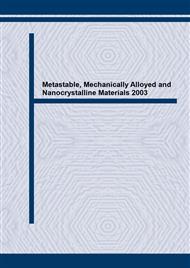[1]
A.R. Yavari, M.F. de Olivera, C. Kiminami, A.Inoue and W.J. Botta F, Mater. Sci. Eng A, in press.
Google Scholar
[2]
de Olivera M., Botta W.J., and Yavari A.R., J. Metastable Nanocryst. Mater.,10,1 (2001)
Google Scholar
[3]
T.Benameur, K. Hajlaoui, A. R.Yavari, A. Inoue and B. Rezgui, Mater. Trans., JIM.V. 43,10 (2002)
Google Scholar
[4]
Z.F. Zhang , J. Eckert, L. Schultz., Acta Mater .51 (2003) 1167-1179
Google Scholar
[5]
Maillet D., André A., Batsale J-C., Degiovanni A., Moyne C., « thermal quadrupoles », John Wiley et Sons Ltd, 2000.
Google Scholar
[6]
Yves JANNOT., « Transfert Thermique » 2002.
Google Scholar
[7]
Spiegel M.R., « transformée de Laplace, cours et problème », Schaum, 1990.
Google Scholar
[8]
F. Spaepen, Acta. Metall. 25, 407 (1977).
Google Scholar
[9]
A.Inoue, Materials Science Foundation Vol.4 (1998) Radius r0 (mm) Fig. 9: Electrical power evolution during the wtip penetration for a constant current I= 0.5 A Joule power per unit volume (Ω.A2 /mm 2 ) In the super-plastic regime of the BMG, the viscosity which is exponentially dependent on the temperature is the key parameter that control strain rate and hence the rapid penetration. The tip's penetration can be predicted in the following manner: by the passage of constant current I, The heat is generated directly in cross-section S (wtip/BMG). Then, temperature increases as function of time (Fig.5). At the establishment of steady state temperature, around Tg, BMG became super-plastic and the w-tip rapidly penetrates according to ( ) 2 00 )0( tertr ⋅⋅= e& where )0(0r is the initial contact radius, e& is the strain rate given by ( )T App h s e =& and e is the average
Google Scholar


